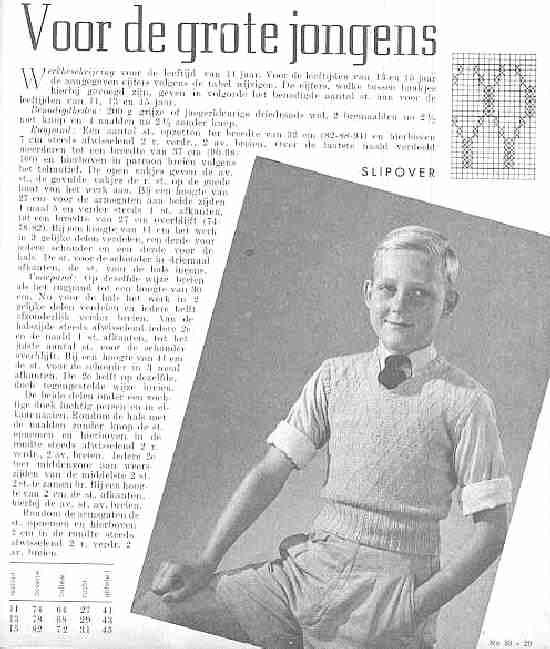
Dutch Boys Sweater Knitting Patterns--1949

Figure 1.--The pattern for this sleeveless sweater appeared in a 1949 Dutch magazine. Note the pattern in the weave even though ot was a solid color sweater. The pattern was for boys 11-15 years of age. The heading reads, "Voor de grote jongens," which would translate as "For the larger lads."
|
Libelle offered a sweater pattern for older boys. It is a pullover for boys 11, 13, and 15 years. There was a pattern in the knitting, but did not use different colors to bring it out.
Libelle was founded in 1933. We know that they were very popular after World War II in
the late 1940s and 50s. A Dutch reader tells us that Libelle is a magazine for woman which
has a special fashion section in it which often included patterns. They not only offer knitting patterns, but all kinds of sewing patterns for mothers and grandmothers to sew at home. Libelle was very popular in the Netherlands as well as Flemish areas of Belgium. Libelle still exists today. The magazine has an internet site, but as it is in Dutch, we can not read it. It appears to be evolving into a life-style magazine and does not give the same attention to fashion as they once did. There are today far fewer patterns, reflecting the fact that fewer Futch mothers now sew their own and their children's clothes.
Terminolgy
Note that the Dutch term for "pullover" is "slipover".
Ages
The garments shown here are for boys from 11-15 years, varying with each outfit.
Garments
Libelle in one 1949 issue offered Libelle offered a sweater pattern for older boys. It is a pullover for boys 11, 13, and 15 years. The pattern is headed, "Voor de grote jongens" (For the big boys). The aricles priovides knitting instructions for knitting the sweater. The instruction are for the 11 size. For the ages of 13 and 15 years you have to change the numbers, which are in brackets, according to the table at the bottom of the page.
Needed: 200g grey or "jaeger?" wool.
Pattern
Dutch boys wore a wide variety of patterned sweaters. Patterns can be made in both different colors as well as the same color
with variations in knitting to provide a less pronounced pattern. The solid-colored flat-weave sweater so common in England do not seem to have been as popular in the Netherlands. Dutch mothers weaving sweaters apparently wantedf to introduce some
color and destinctive design elements. We are less sure about what the boys thought or indeed if they even noticed the different patterns to any extent. HBC has, however, only limited information on patterns at this time.
Christopher Wagner

Navigate the Boys' Historical Clothing catalog/magazine pages:
[Return to the Main Dutch 1949 mail order and advertisement page]
[Main photo/publishing page]
[Store catalogs]
[Fashion magazines]
Navigate the Boys' Historical Clothing Web Site:
[Introduction]
[Activities]
[Biographies]
[Chronology]
[Clothing styles]
[Countries]
[Bibliographies]
[Contributions]
[FAQs]
[Dutch glossary]
[Satellite sites]
[Tools]
[Boys' Clothing Home]
Navigate the Boys' Historical Clothing Web Site:
[Sailor suits]
[Sailor hats]
[Buster Brown suits]
[Eton suits]
[Rompers]
[Tunics]
[Smocks]
[Pinafores]
Created: April 24, 2002
Last updated: April 24, 2002




